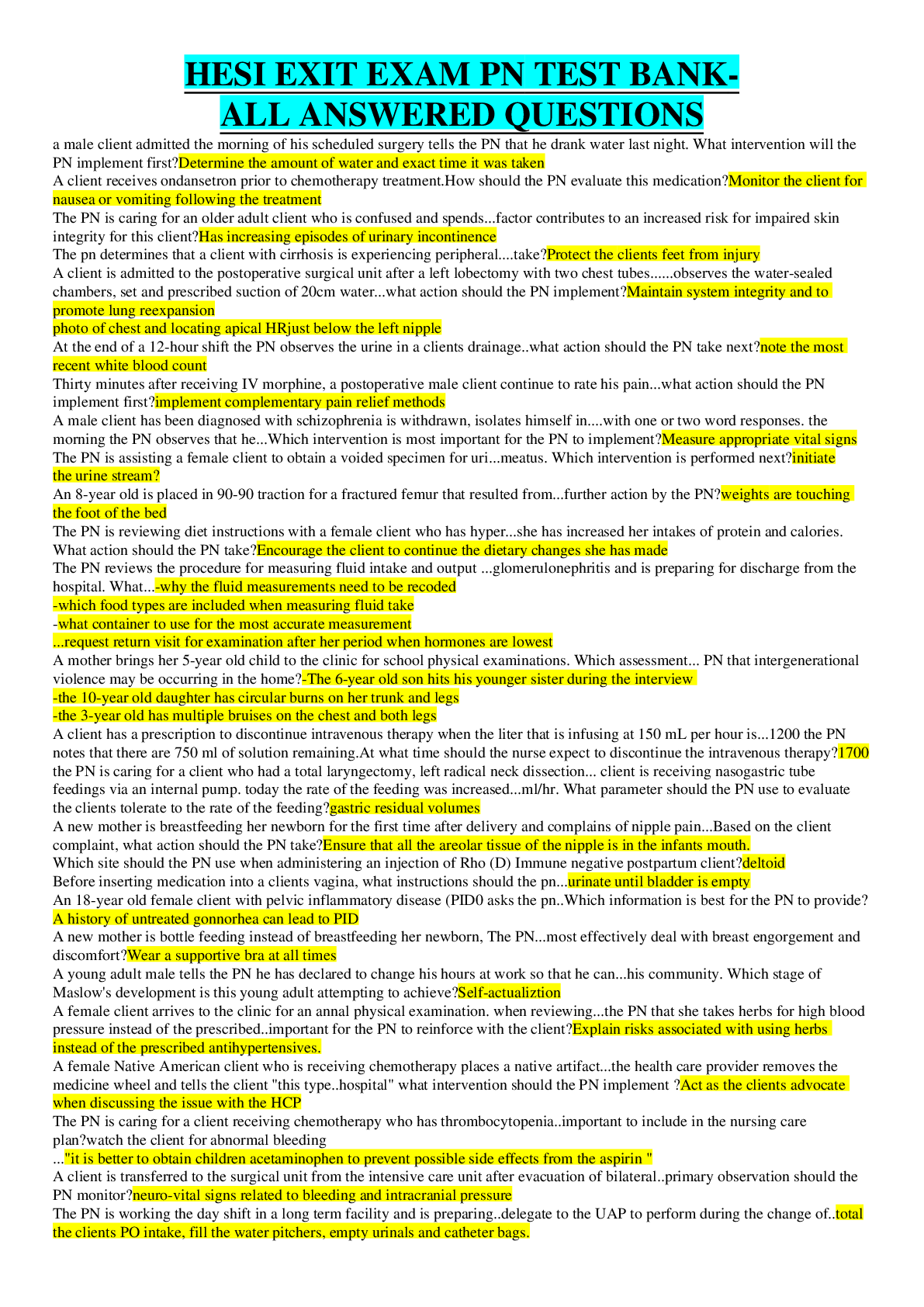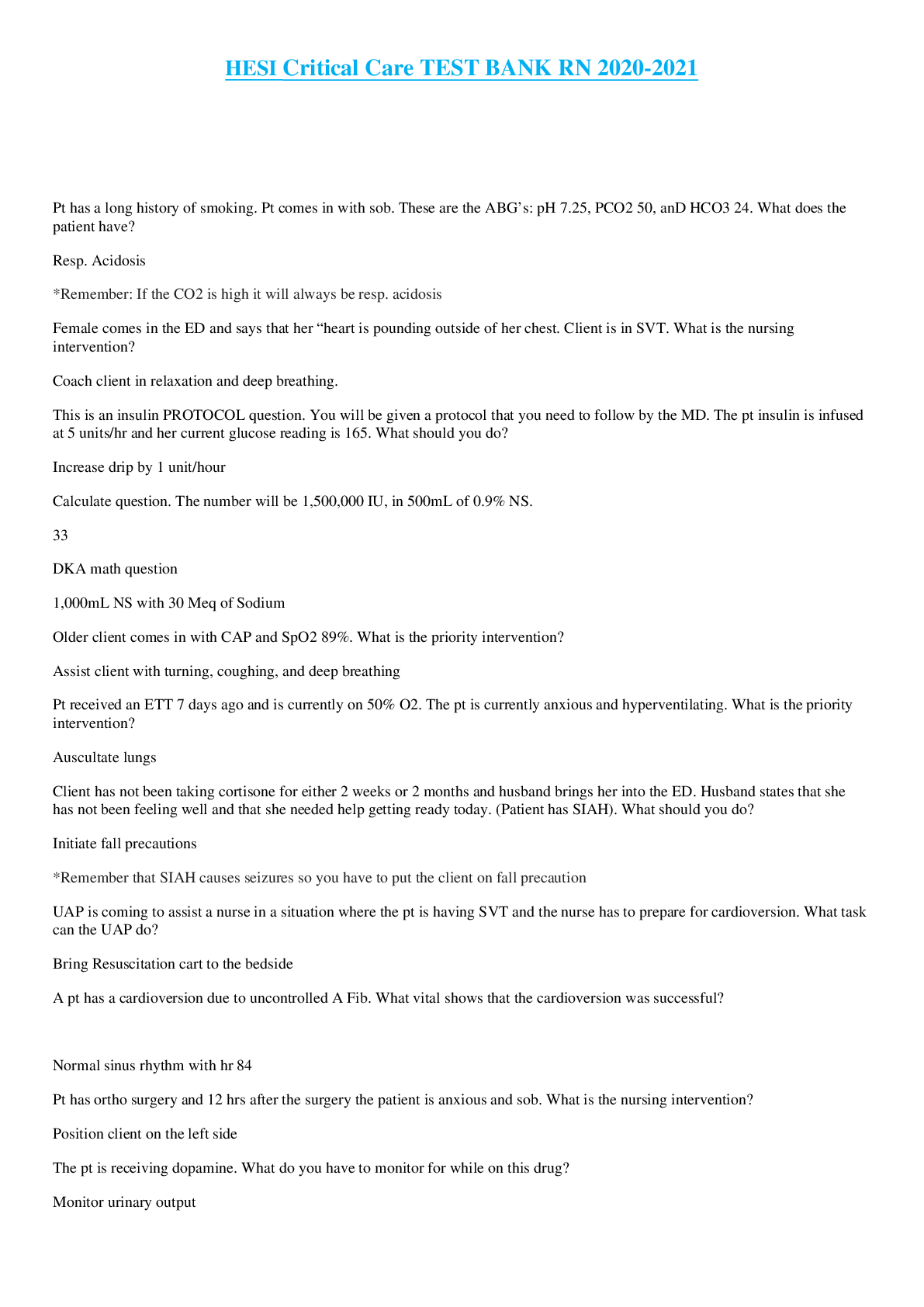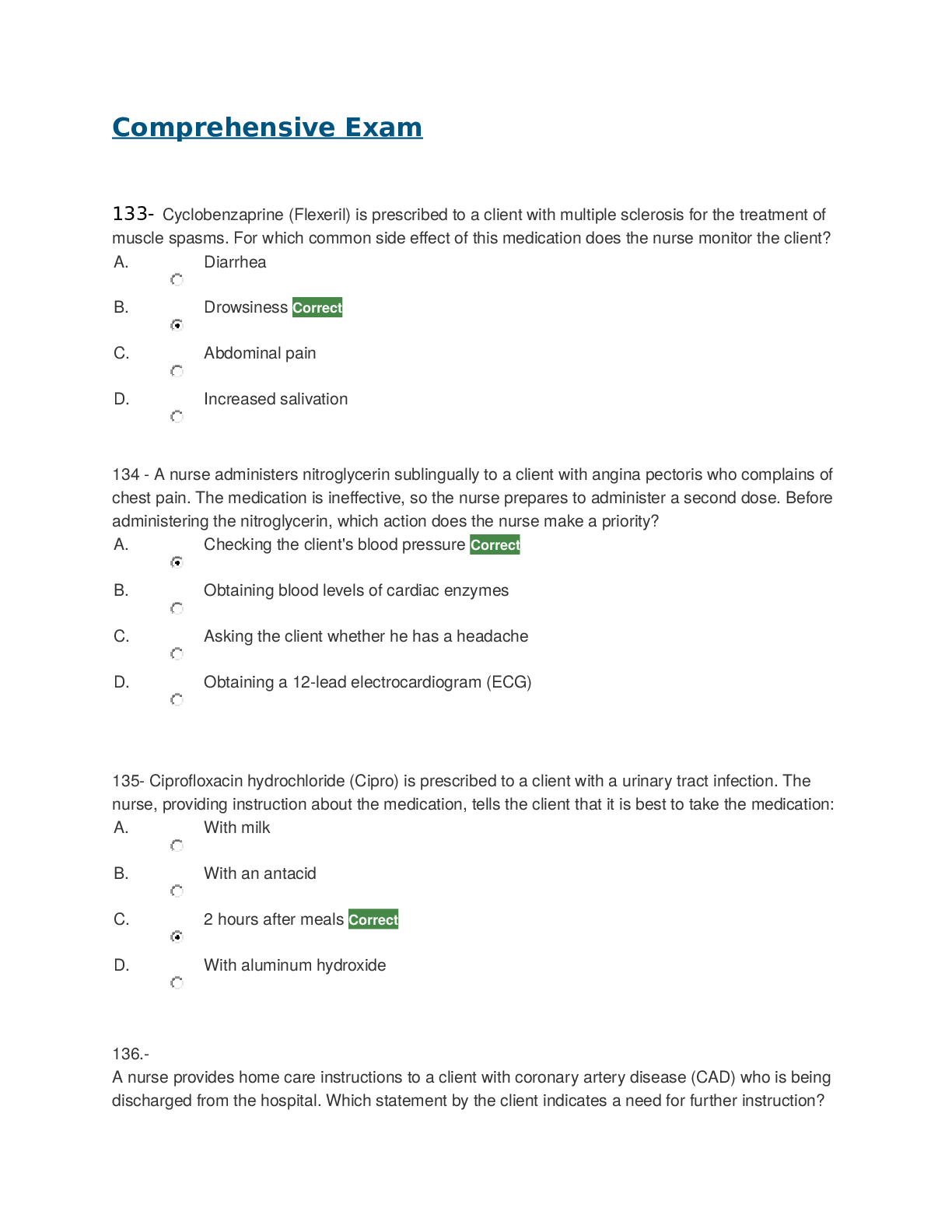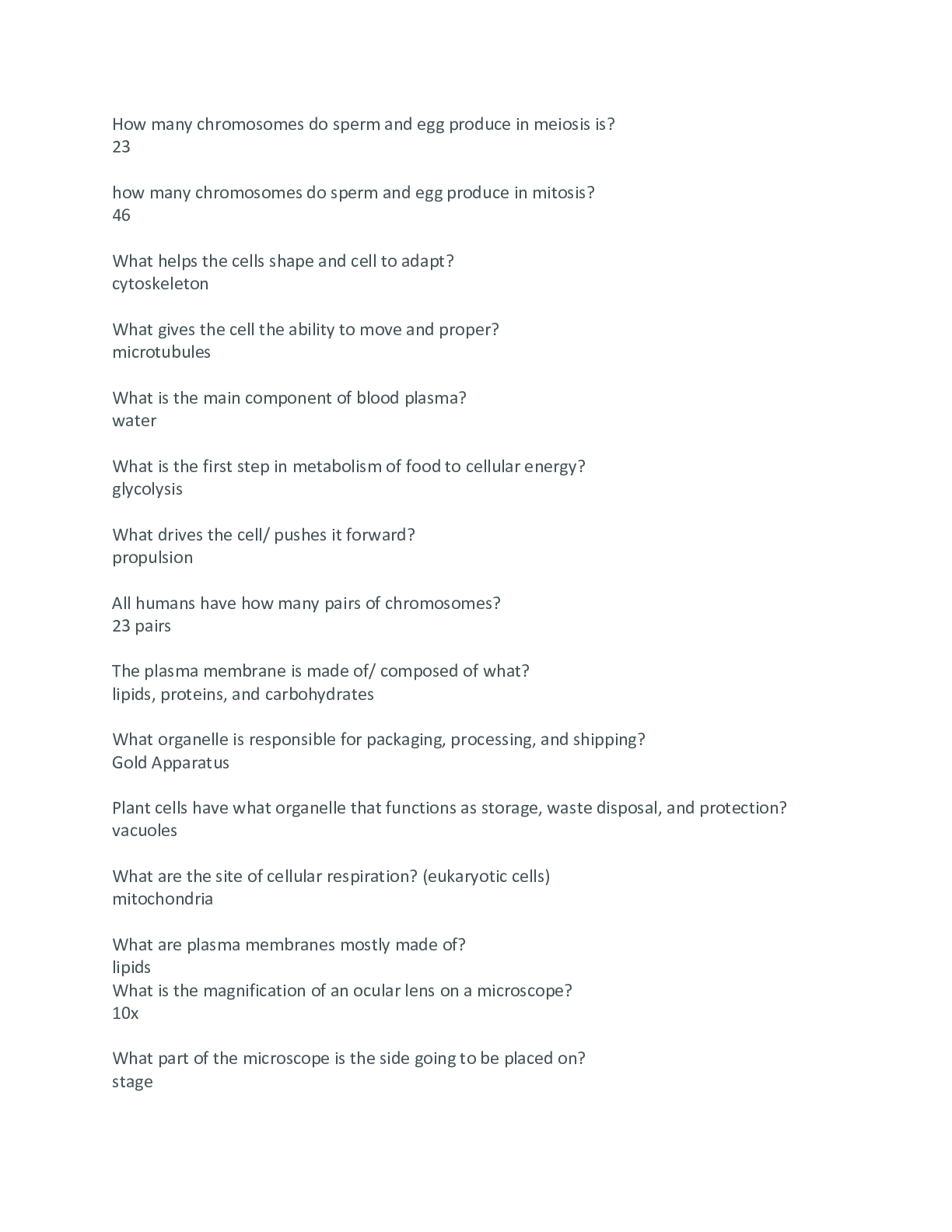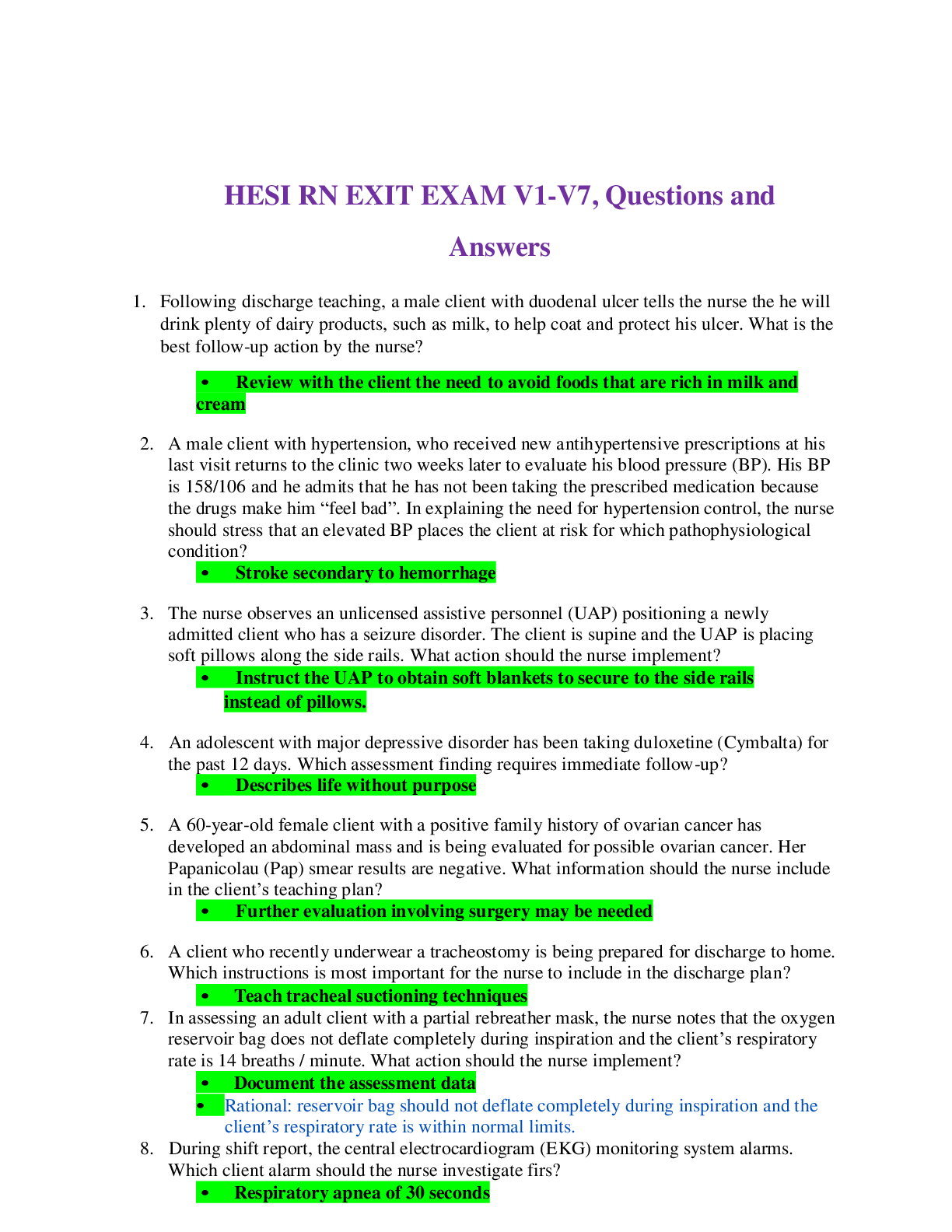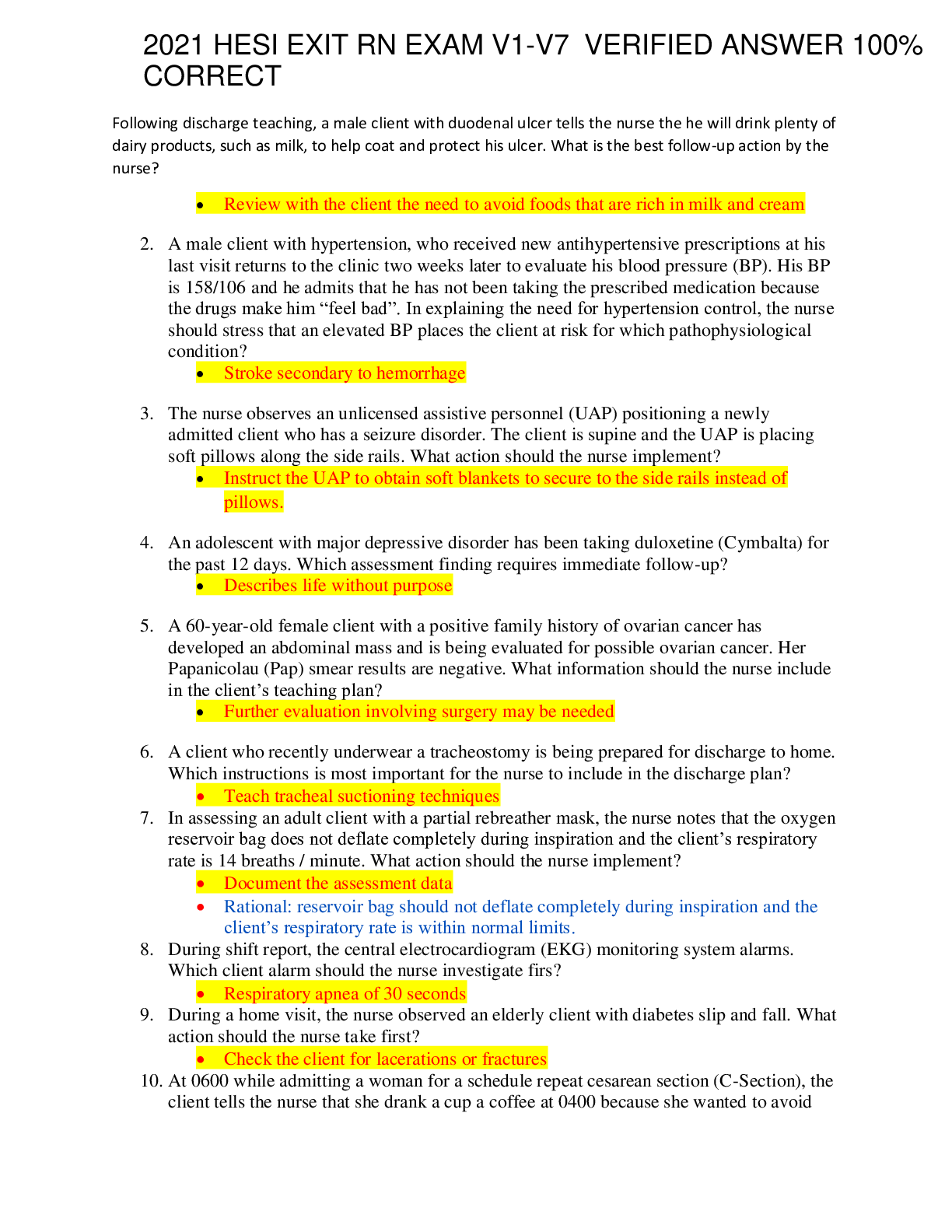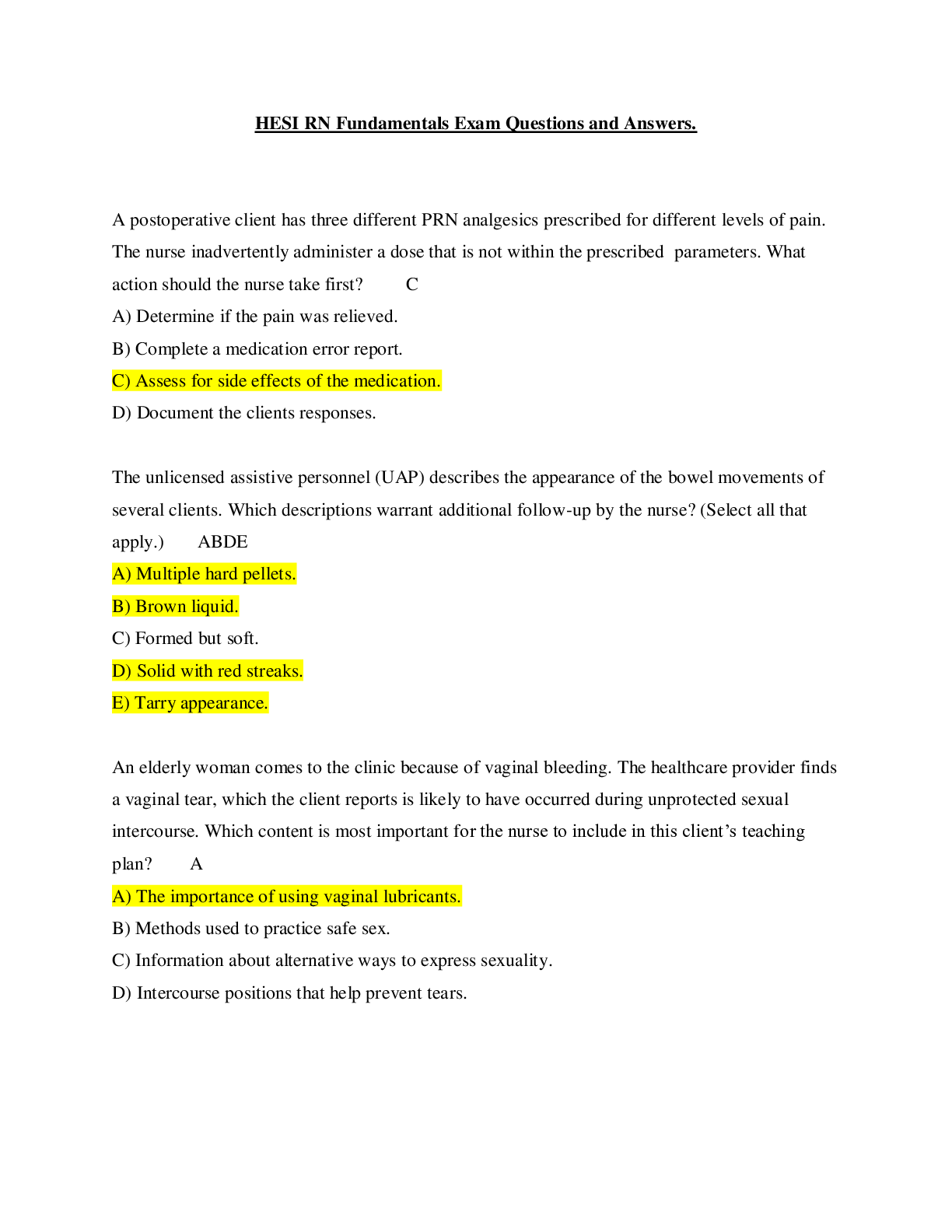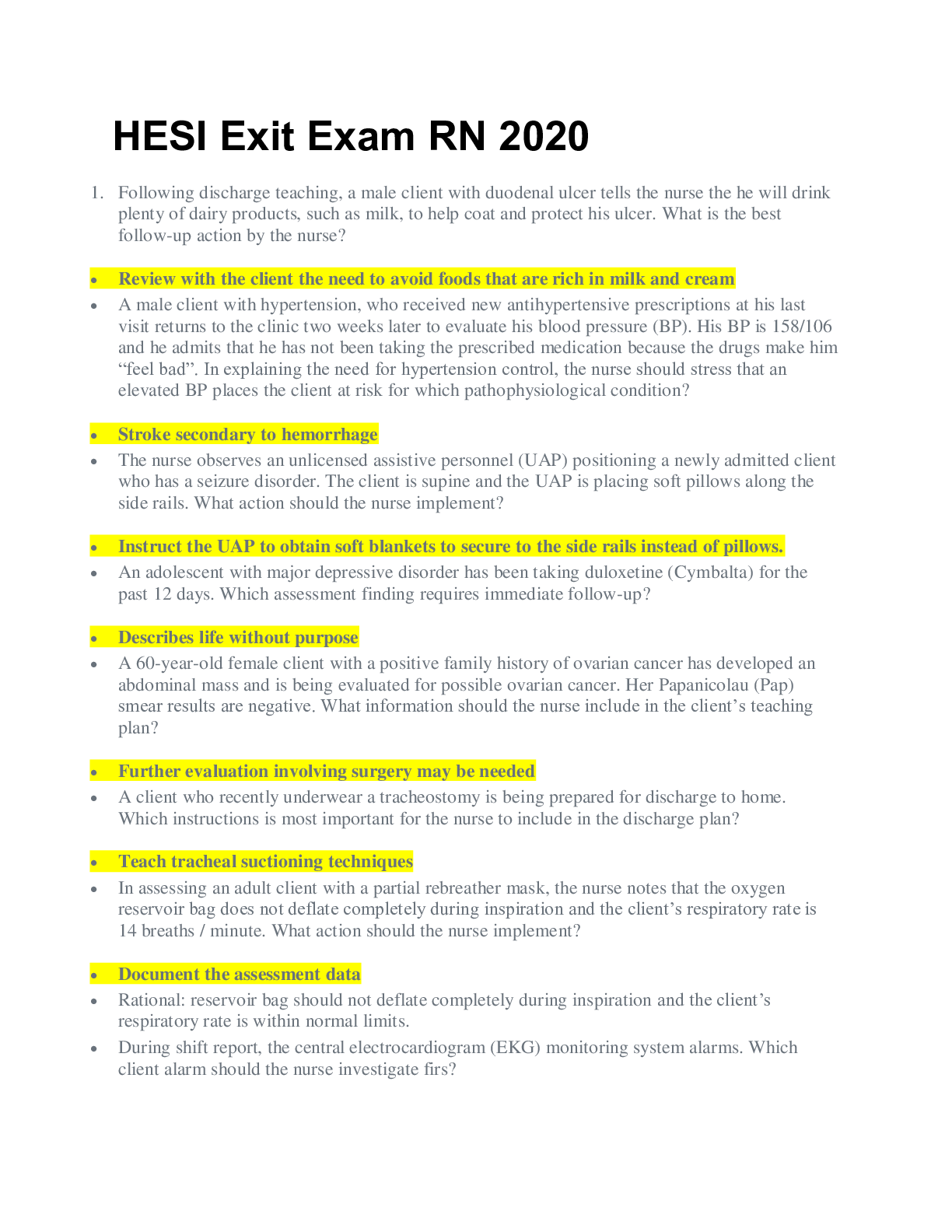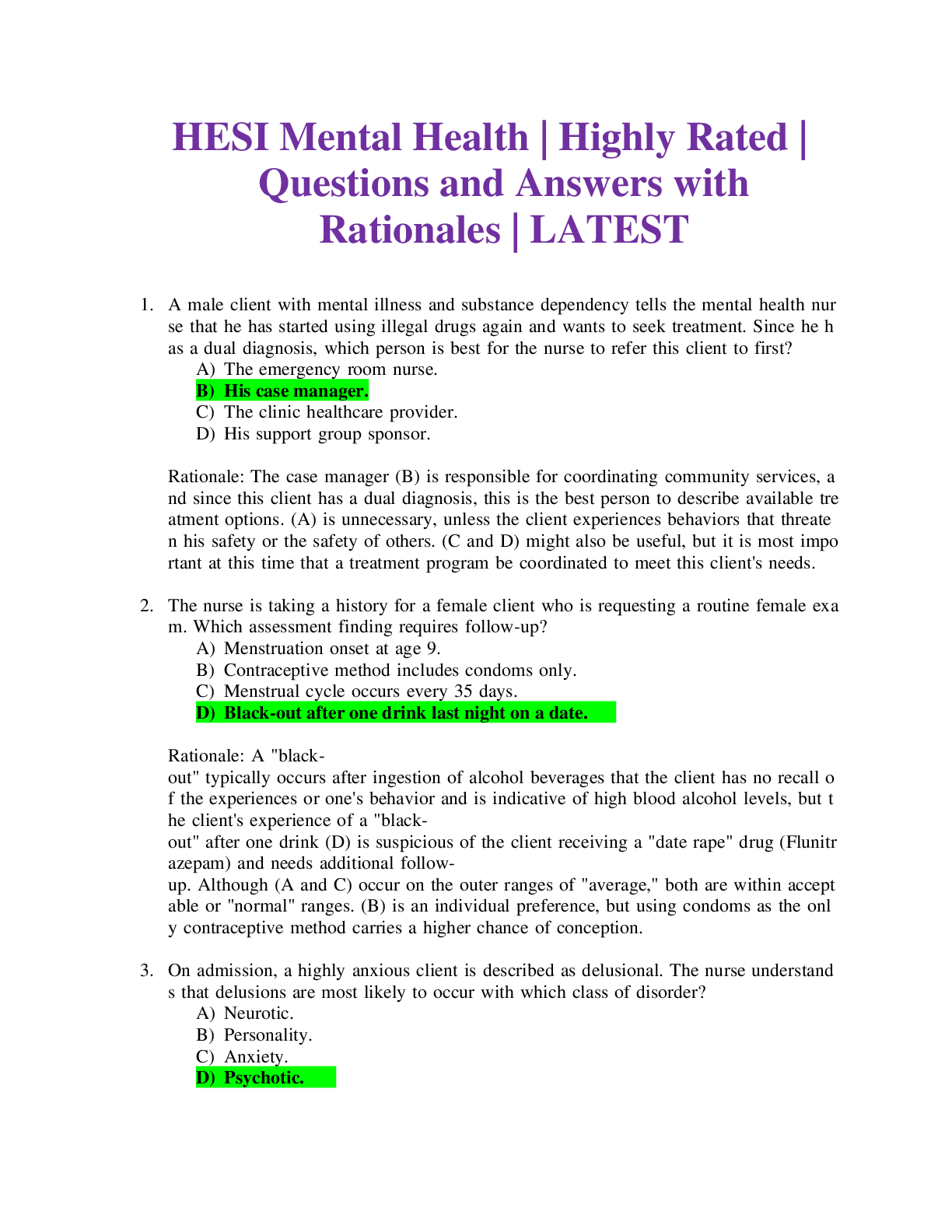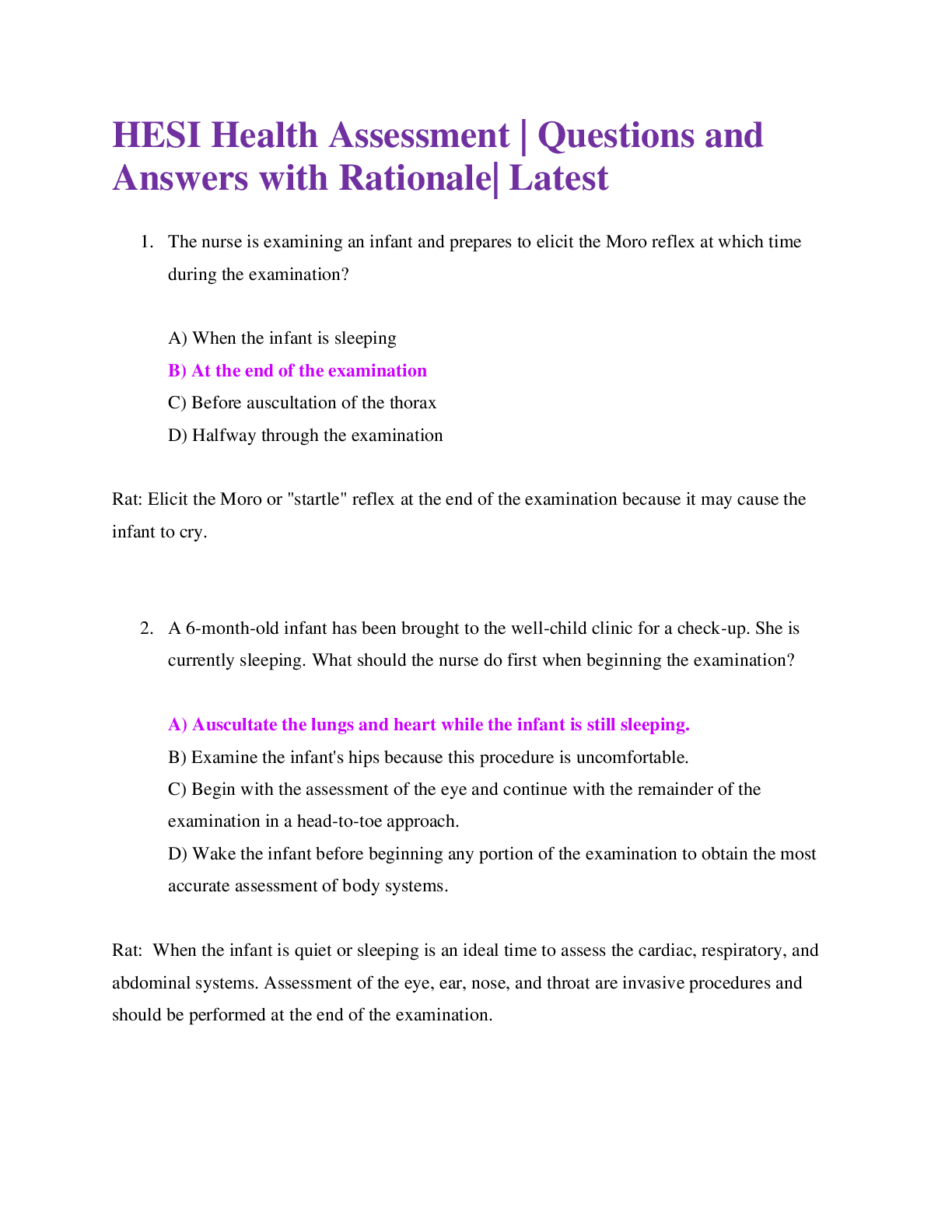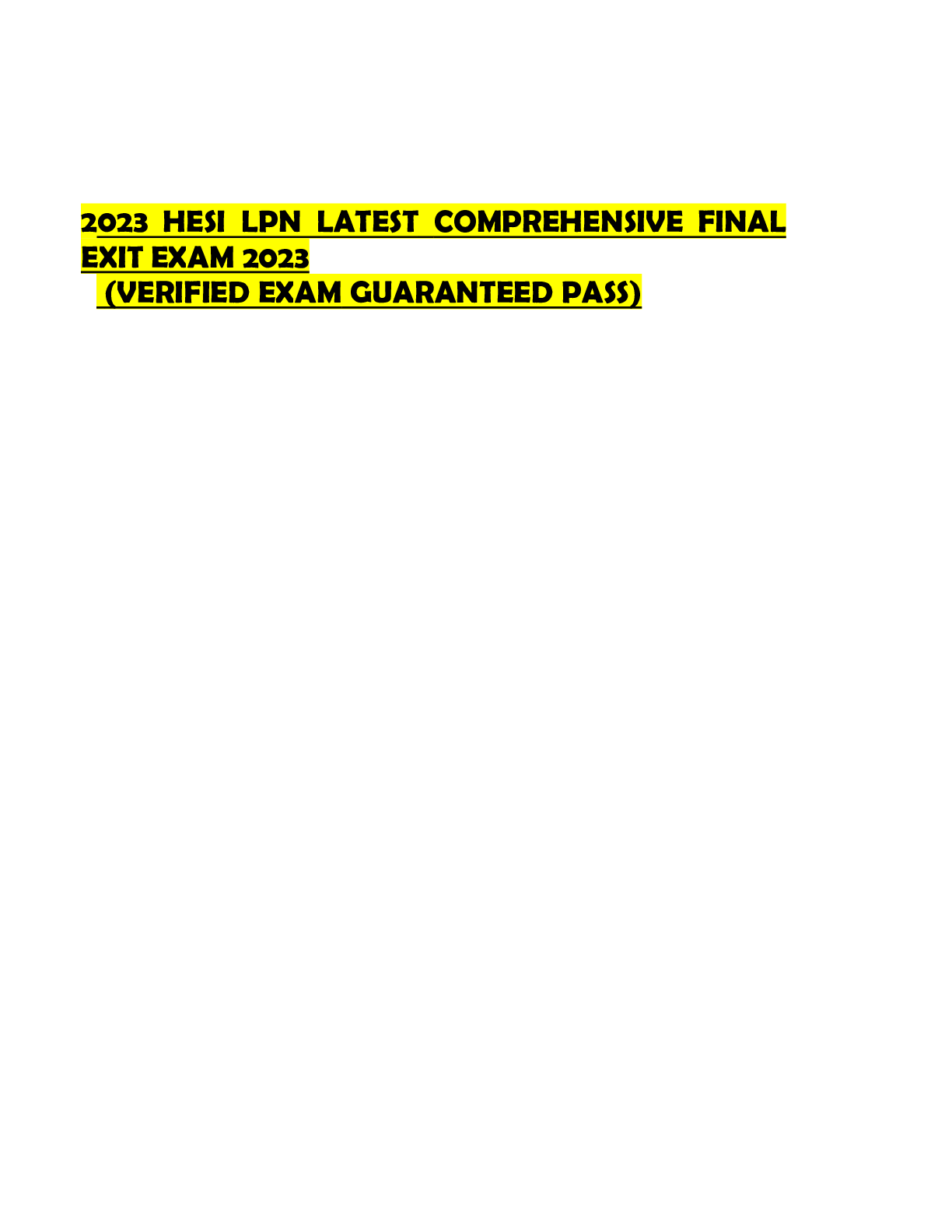Fundamental PN HESI | NEW VERSION 2021
Document Content and Description Below
FUNDAMENTAL PN HESI 1) A client who is in hospice care complains of increasing amounts of pain. The healthcare provider prescribes an analgesic every four hours as needed. Which action should the ... LPN/LVN implement? 2) When assessing a client with wrist restraints, the nurse observes that the fingers on the right hand are blue. What action should the LPN implement first? 3) The LPN/LVN is assessing the nutritional status of several clients. Which client has the greatest nutritional need for additional intake of protein? 4) A client is in the radiology department at 0900 when the prescription levofloxacin (Levaquin) 500 mg IV q24h is scheduled to be administered. The client returns to the unit at 1300. What is the best intervention for the LPN/LVN to implement? 5) While instructing a male client's wife in the performance of passive range- of-motion exercises to his contracted shoulder, the nurse observes that she is holding his arm above and below the elbow. What nursing action should the LPN/LVN implement? 6) What is the most important reason for starting intravenous infusions in the upper extremities rather than the lower extremities of adults? 7) The LPN observes an unlicensed assistive personnel (UAP) taking a client's blood pressure with a cuff that is too small, but the blood pressure reading obtained is within the client's usual range. What action is most important for the nurse to implement? 8) A client is to receive cimetidine (Tagamet) 300 mg q6h IVPB. The preparation arrives from the pharmacy diluted in 50 ml of 0.9% NaCl. The LPN plans to administer the IVPB dose over 20 minutes. For how many ml/ hr should the infusion pump be set to deliver the secondary infusion? 9) Twenty minutes after beginning a heat application, the client states that the heating pad no longer feels warm enough. What is the best response by the LPN/LVN? 10) The LPN is instructing a client with high cholesterol about diet and life style modification. What comment from the client indicates that the teaching has been effective? 11) The UAPs working on a chronic neuro unit ask the LPN/LVN to help them determine the safest way to transfer an elderly client with left-sided weakness from the bed to the chair. What method describes the correct transfer procedure for this client? 12) An unlicensed assistive personnel (UAP) places a client in a left lateral position prior to administering a soap suds enema. Which instruction should the LPN/LVN provide the UAP? 13) A client who is a Jehovah's Witness is admitted to the nursing unit. Which concern should the LPN have for planning care in terms of the client's beliefs? 14) The LPN/LVN observes that a male client has removed the covering from an ice pack applied to his knee. What action should the nurse take first? 15) The LPN/LVN mixes 50 mg of Nipride in 250 ml of D5W and plans to administer the solution at a rate of 5 mcg/kg/min to a client weighing 182 pounds. Using a drip factor of 60 gtt/ml, how many drops per minute should the client receive? 16) A hospitalized male client is receiving nasogastric tube feedings via a small-bore tube and a continuous pump infusion. He reports that he had a bad bout of severe coughing a few minutes ago, but feels fine now. What action is best for the LPN/LVN to take? 17) A male client being discharged with a prescription for the bronchodilator theophylline tells the nurse that he understands he is to take three doses of the medication each day. Since, at the time of discharge, timed-release capsules are not available, which dosing schedule should the LPN advise the client to follow? 18) A client is to receive 10 mEq of KCl diluted in 250 ml of normal saline over 4 hours. At what rate should the LPN/LVN set the client's intravenous infusion pump? 19) An obese male client discusses with the LPN/LVN his plans to begin a long-term weight loss regimen. In addition to dietary changes, he plans to begin an intensive aerobic exercise program 3 to 4 times a week and to take stress management classes. After praising the client for his decision, which instruction is most important for the nurse to provide? 20) The LPN is teaching a client proper use of an inhaler. When should the client administer the inhaler-delivered medication to demonstrate correct use of the inhaler? 21) The healthcare provider prescribes the diuretic metolazone (Zaroxolyn) 7.5 mg PO. Zaroxolyn is available in 5 mg tablets. How much should the LPN/LVN plan to administer? 22) The healthcare provider prescribes furosemide (Lasix) 15 mg IV stat. On hand is Lasix 20 mg/2 ml. How many milliliters should the LPN/LVN administer? 23) Heparin 20,000 units in 500 ml D5W at 50 ml/hour has been infusing for 5½ hours. How much heparin has the client received? 24) The healthcare provider prescribes morphine sulfate 4mg IM STAT. Morphine comes in 8 mg per ml. How many ml should the LPN/LVN administer? 25) The LPN prepares a 1,000 ml IV of 5% dextrose and water to be infused over 8 hours. The infusion set delivers 10 drops per milliliter. The nurse should regulate the IV to administer approximately how many drops per minute? 26) Which action is most important for the LPN/LVN to implement when donning sterile gloves? 27) A client's infusion of normal saline infiltrated earlier today, and approximately 500 ml of saline infused into the subcutaneous tissue. The client is now complaining of excruciating arm pain and demanding "stronger pain medications." What initial action is most important for the LPN/LVN to take? 28) An elderly male client who is unresponsive following a cerebral vascular accident (CVA) is receiving bolus enteral feedings though a gastrostomy tube. What is the best client position for administration of the bolus tube feedings? 29) A 73-year-old female client had a hemiarthroplasty of the left hip yesterday due to a fracture resulting from a fall. In reviewing hip precautions with the client, which instruction should the LPN/LVN include in this client's teaching plan? 30) A client with pneumonia has a decrease in oxygen saturation from 94% to 88% while ambulating. Based on these findings, which intervention should the LPN/LVN implement first? 31) A client with chronic renal failure selects a scrambled egg for his breakfast. What action should the LPN/LVN take? 32) A client who is 5' 5" tall and weighs 200 pounds is scheduled for surgery the next day. What question is most important for the LPN to include during the preoperative assessment? 33) During the initial morning assessment, a male client denies dysuria but reports that his urine appears dark amber. Which intervention should the LPN/LVN implement? A. Provide additional coffee on the client's breakfast tray. 34) Which intervention is most important for the LPN/LVN to implement for a male client who is experiencing urinary retention? 35) A client with acute hemorrhagic anemia is to receive four units of packed RBCs (red blood cells) as rapidly as possible. Which intervention is most important for the LPN/LVN to implement? 36) Which snack food is best for the LPN/LVN to provide a client with myasthenia gravis who is at risk for altered nutritional status? 37) The nurse is evaluating client learning about a low-sodium diet. Selection of which meal would indicate to the LPN that this client understands the dietary restrictions? 38) Which nutritional assessment data should the LPN/LVN collect to best reflect total muscle mass in an adolescent? 39) An elderly resident of a long-term care facility is no longer able to perform self-care and is becoming progressively weaker. The resident previously requested that no resuscitative efforts be performed, and the family requests hospice care. What action should the LPN/LVN implement first? 40) After completing an assessment and determining that a client has a problem, which action should the LPN/LVN perform next? 41) An elderly client who requires frequent monitoring fell and fractured a hip. Which LPN/LVN is at greatest risk for a malpractice judgment? 42) A postoperative client will need to perform daily dressing changes after discharge. Which outcome statement best demonstrates the client's readiness to manage his wound care after discharge? The client 43) When evaluating a client's plan of care, the LPN determines that a desired outcome was not achieved. Which action will the LPN implement first? 44) The healthcare provider prescribes 1,000 ml of Ringer's Lactate with 30 Units of Pitocin to run in over 4 hours for a client who has just delivered a 10 pound infant by cesarean section. The tubing has been changed to a 20 gtt/ml administration set. The LPN/LVN plans to set the flow rate at how many gtt/min? 45) Seconal 0.1 gram PRN at bedtime is prescribed to a client for rest. The scored tablets are labeled grain 1.5 per tablet. How many tablets should the LPN/LVN plan to administer? 46) Which assessment data would provide the most accurate determination of proper placement of a nasogastric tube? 47) The nurse is caring for a client who is receiving 24-hour total parenteral nutrition (TPN) via a central line at 54 ml/hr. When initially assessing the client, the nurse notes that the TPN solution has run out and the next TPN solution is not available. What immediate action should the LPN/LVN take? 48) When assisting an 82-year-old client to ambulate, it is important for the LPN/LVN to realize that the center of gravity for an elderly person is the 49) In developing a plan of care for a client with dementia, the LPN/LVN should remember that confusion in the elderly 50) An elderly male client who suffered a cerebral vascular accident is receiving tube feedings via a gastrostomy tube. The LPN knows that the best position for this client during administration of the feedings is 51) The nurse notices that the mother a 9-year-old Vietnamese child always looks at the floor when she talks to the nurse. What action should the LPN take? 52) When conducting an admission assessment, the LPN should ask the client about the use of complimentary healing practices. Which statement is accurate regarding the use of these practices? 53) A young mother of three children complains of increased anxiety during her annual physical exam. What information should the LPN/LVN obtain first? 54) Three days following surgery, a male client observes his colostomy for the first time. He becomes quite upset and tells the LPN that it is much bigger than he expected. What is the best response by the nurse? 55) At the time of the first dressing change, the client refuses to look at her mastectomy incision. The LPN tells the client that the incision is healing well, but the client refuses to talk about it. What would be an appropriate response to this client's silence? [Show More]
Last updated: 1 year ago
Preview 1 out of 20 pages

Reviews( 0 )
Document information
Connected school, study & course
About the document
Uploaded On
Feb 20, 2021
Number of pages
20
Written in
Additional information
This document has been written for:
Uploaded
Feb 20, 2021
Downloads
0
Views
71

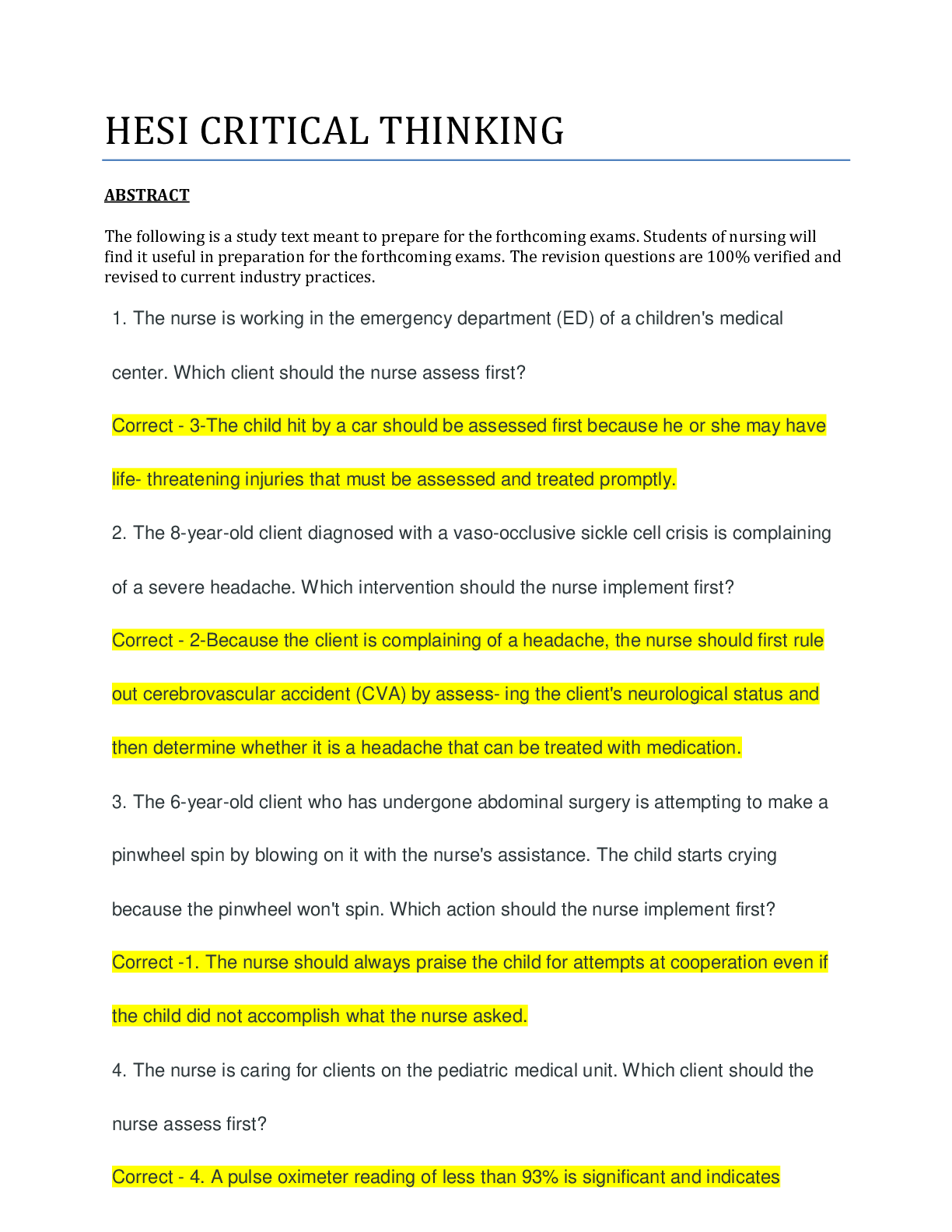
 V1 V2.png)

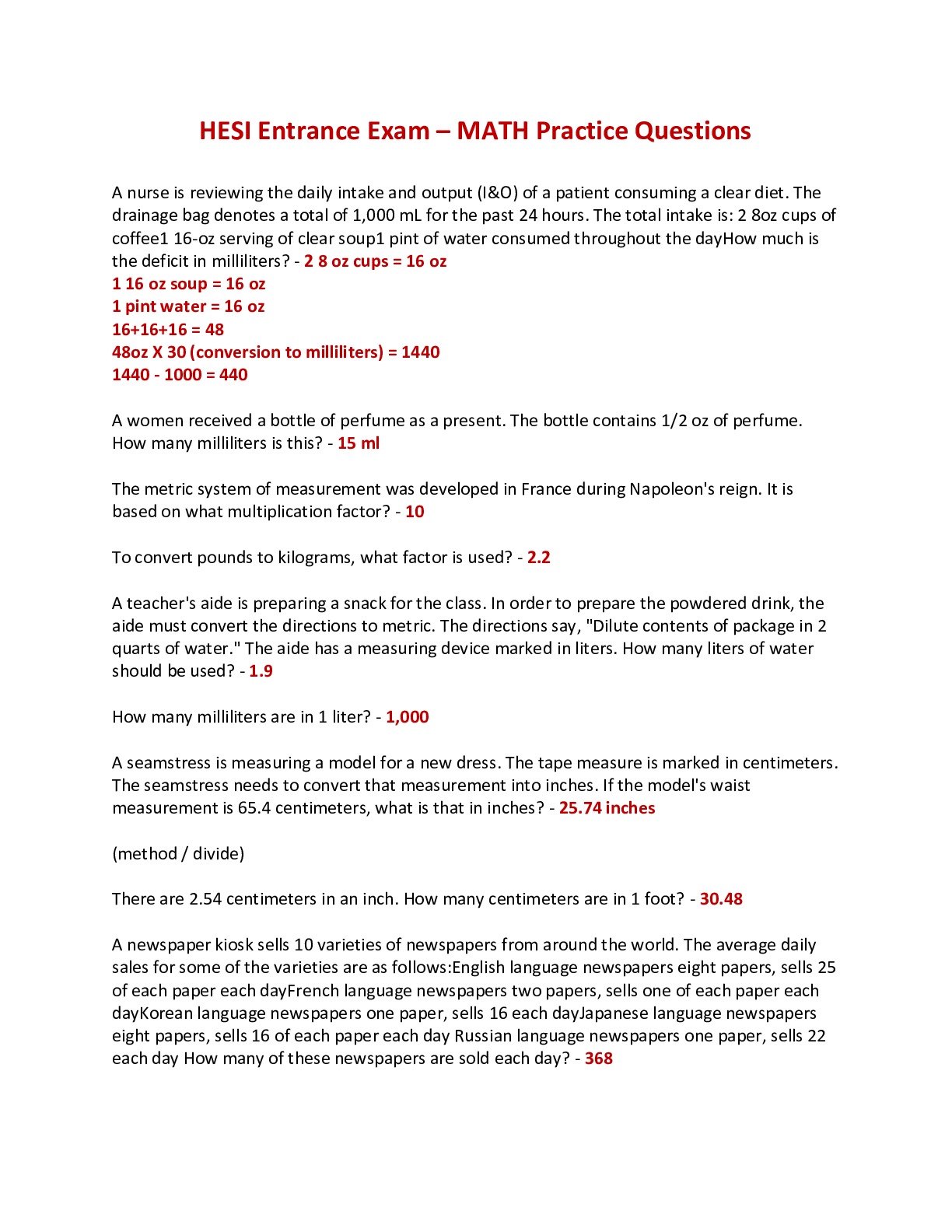
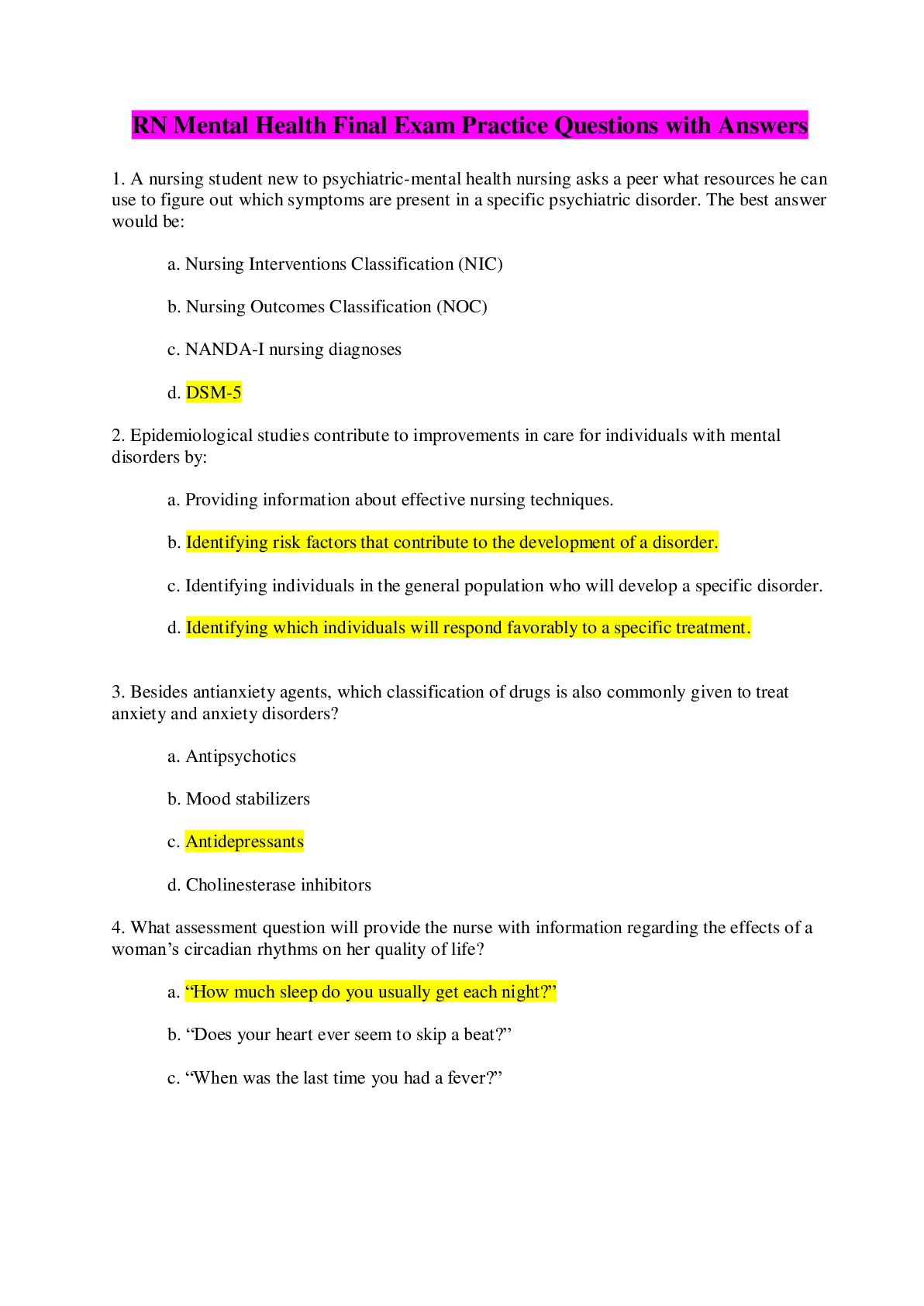
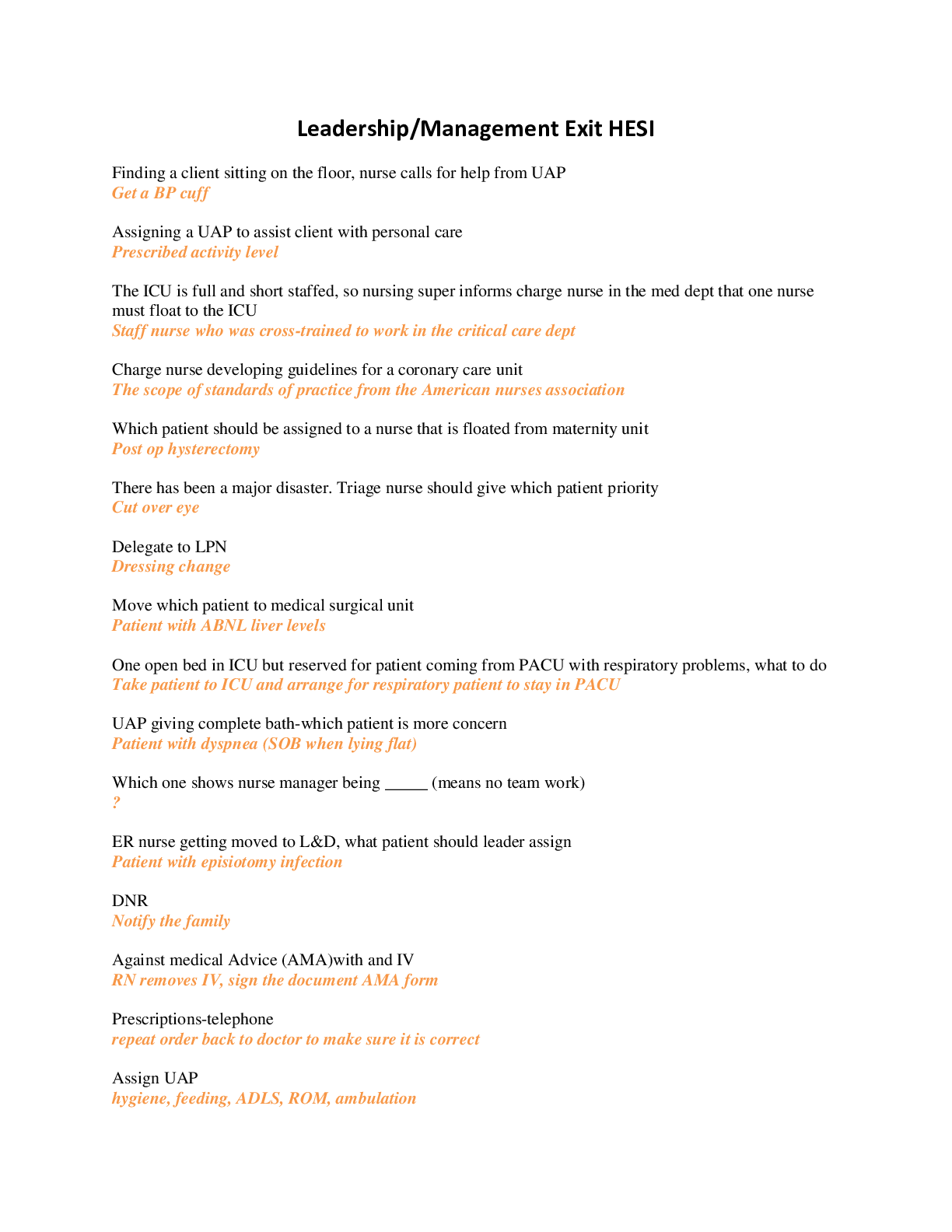
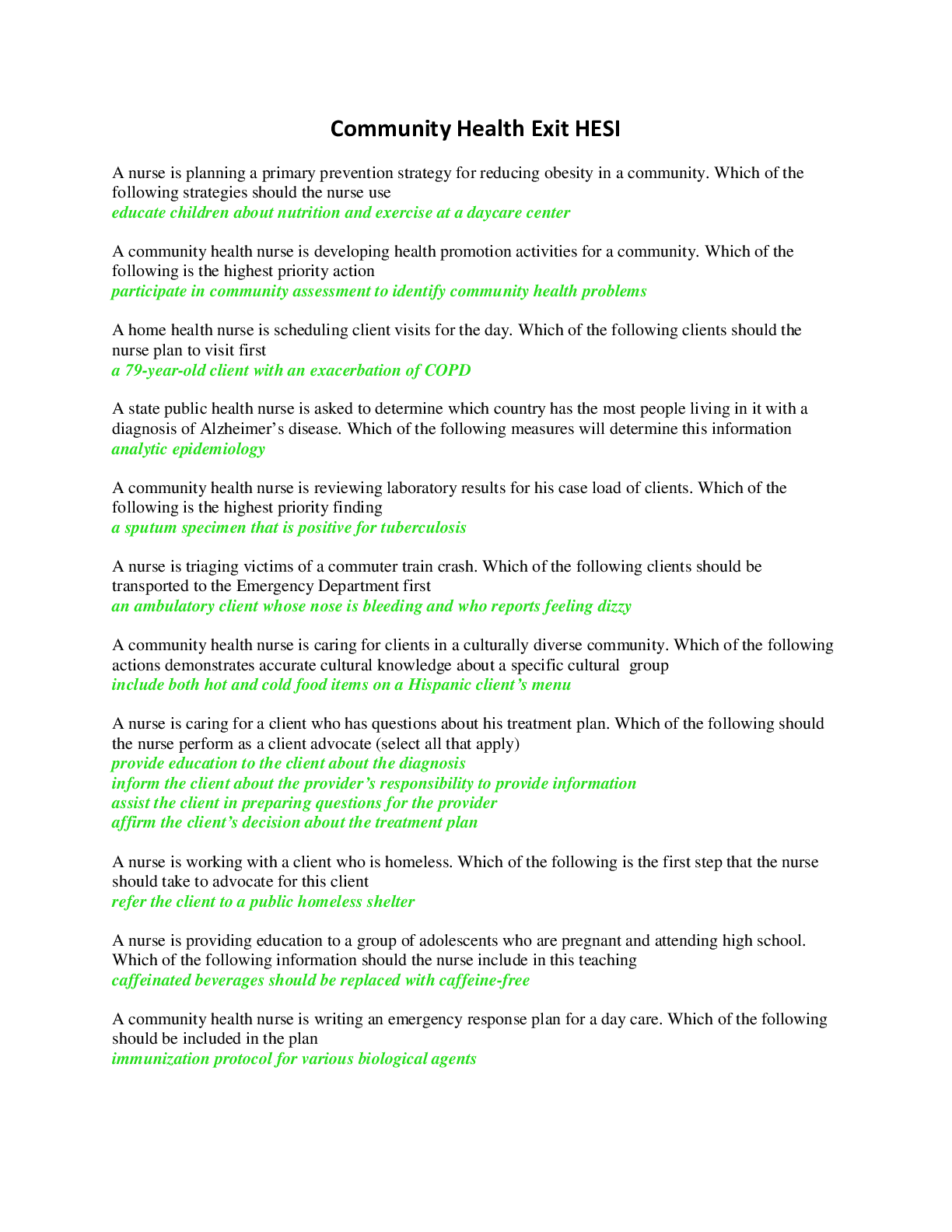
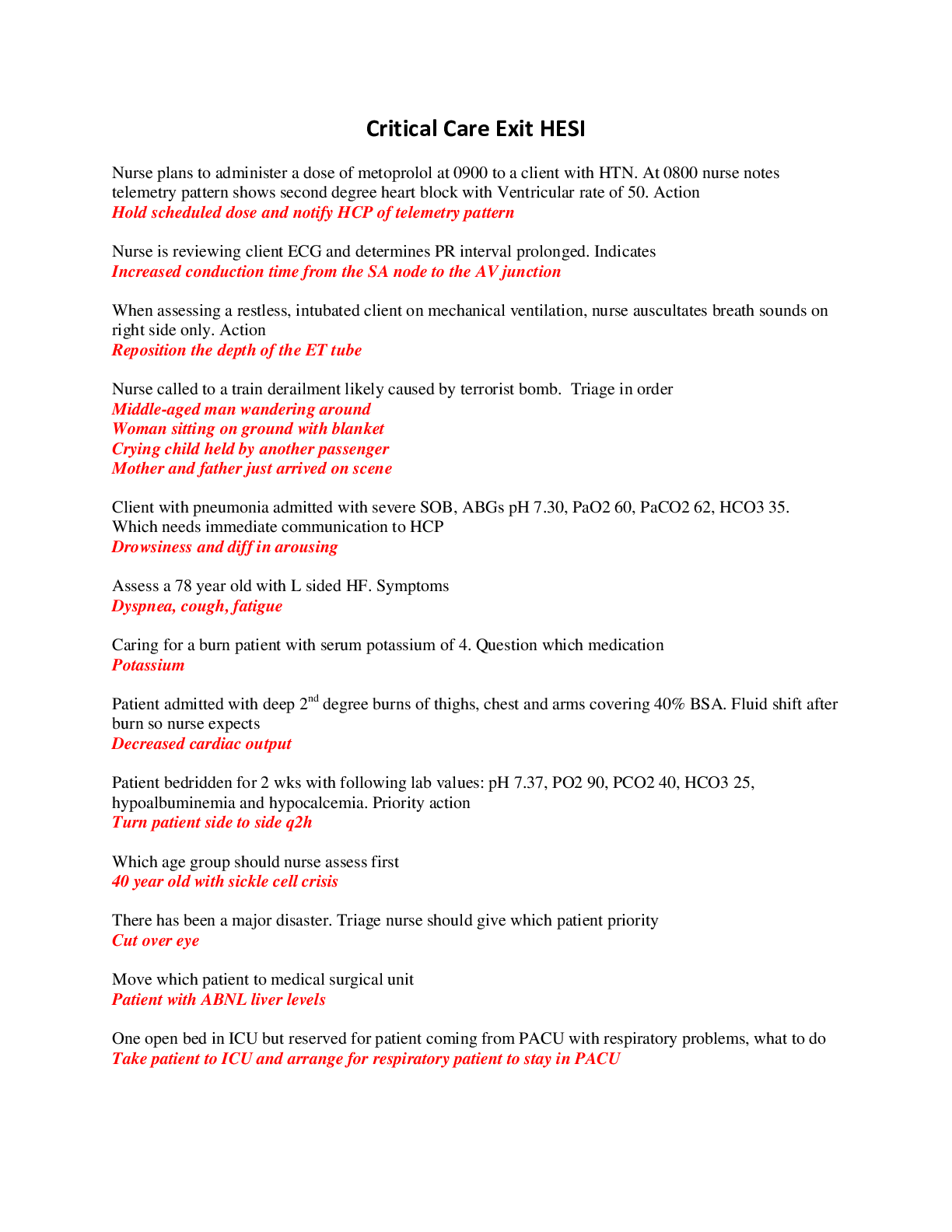
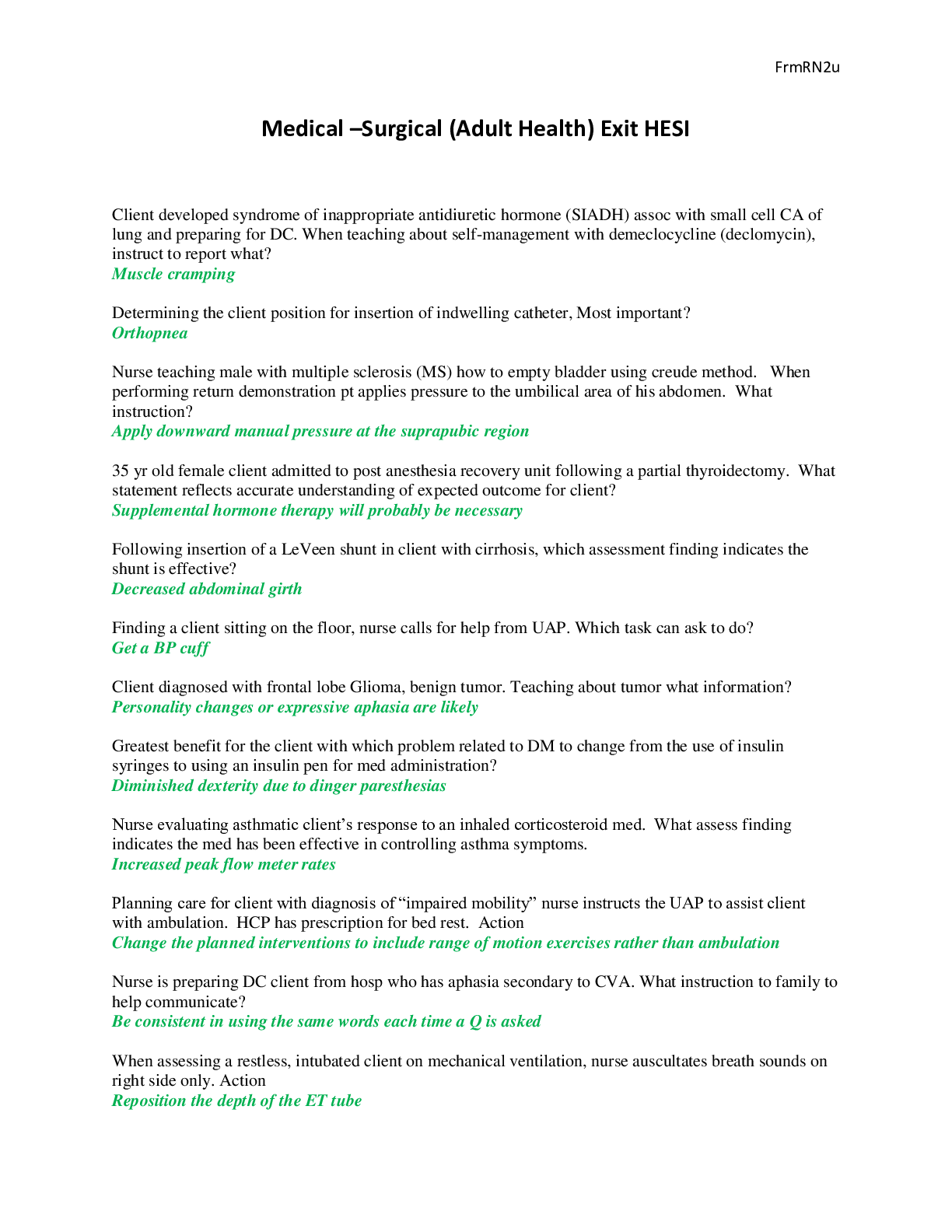
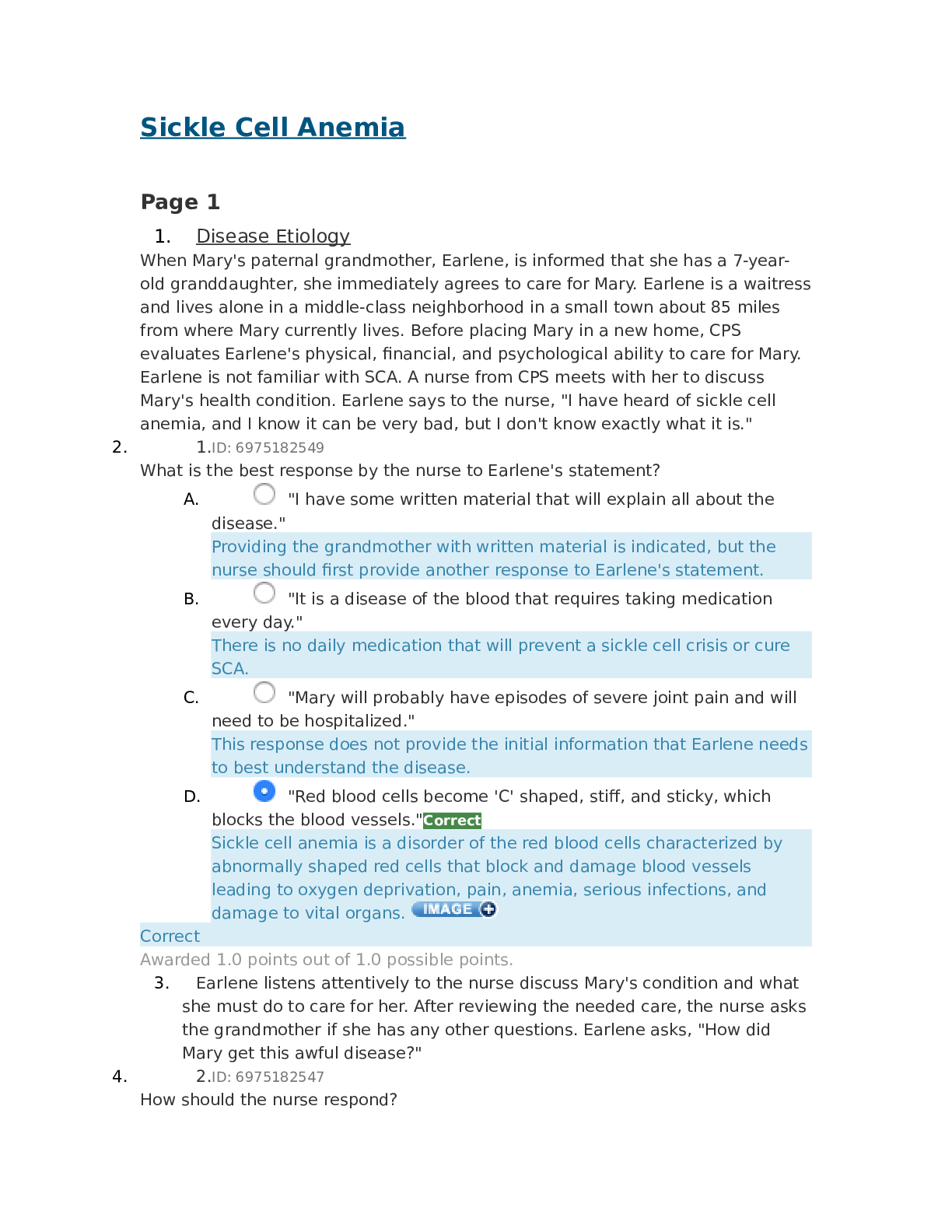
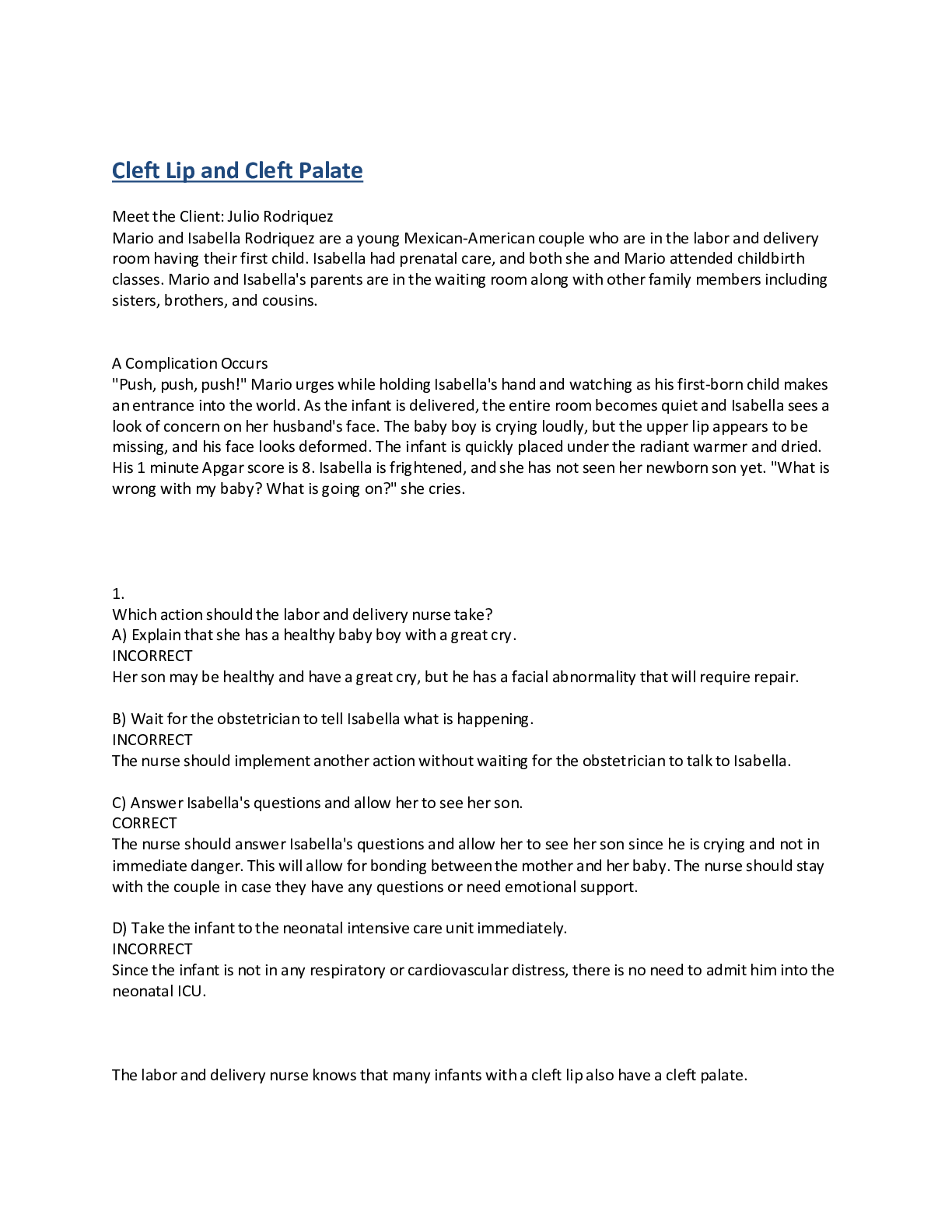
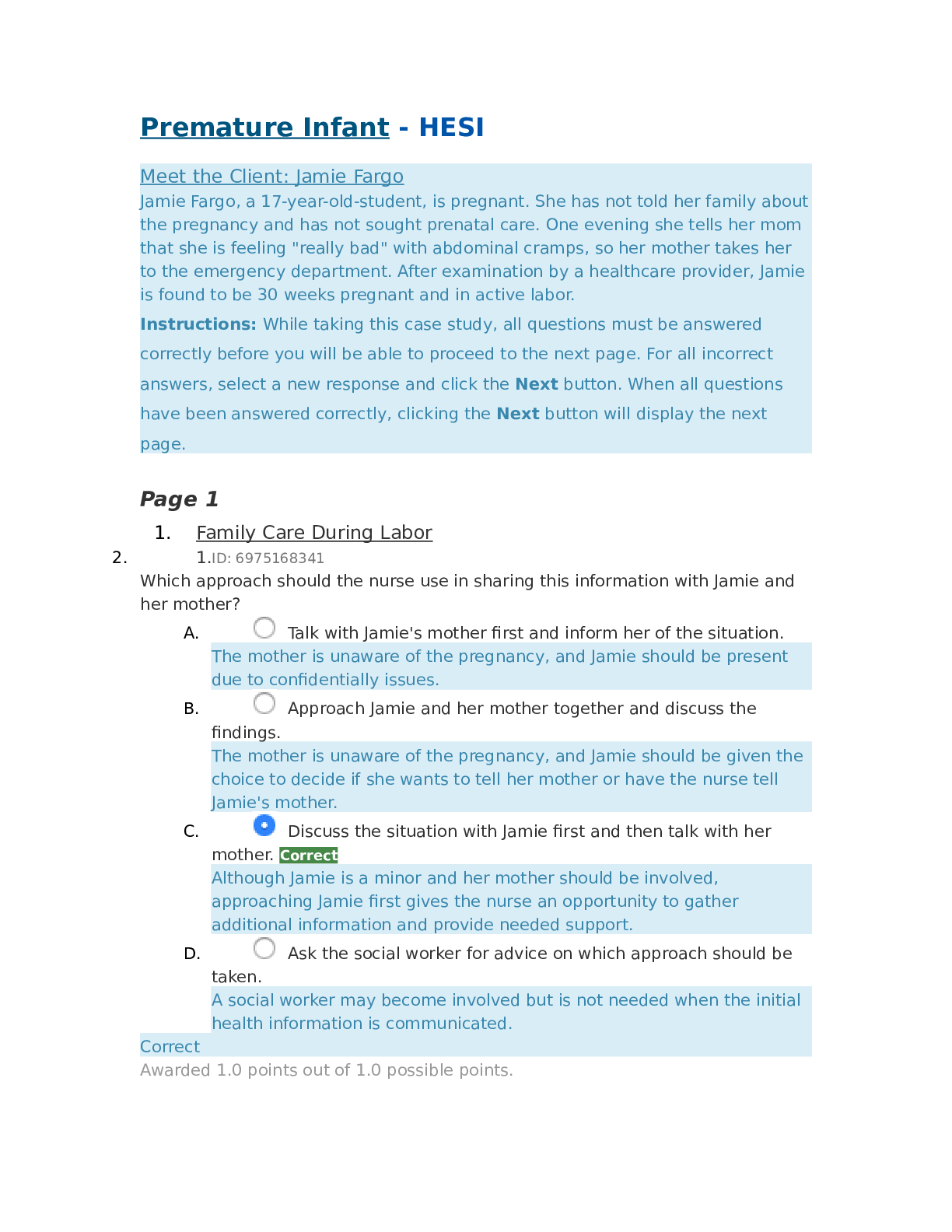
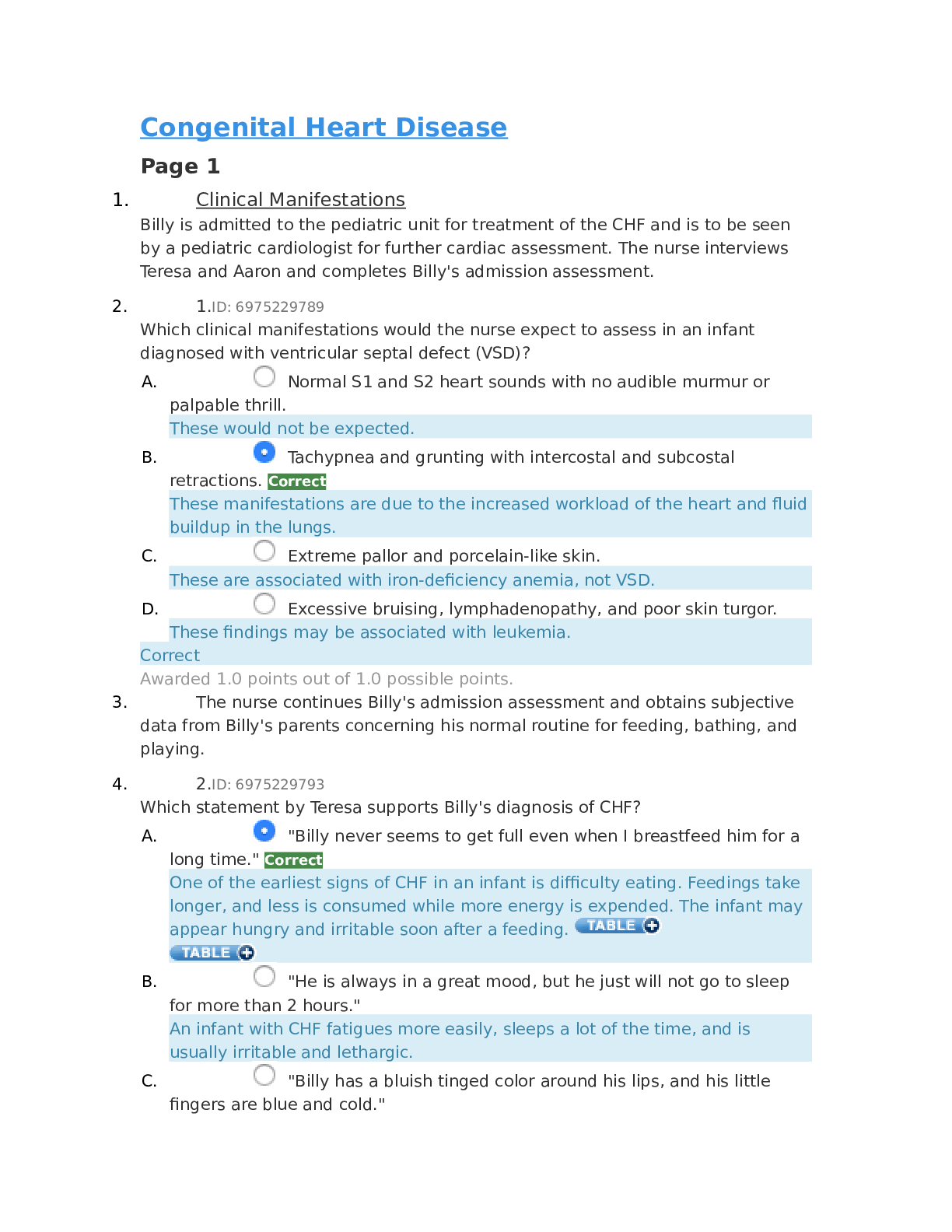
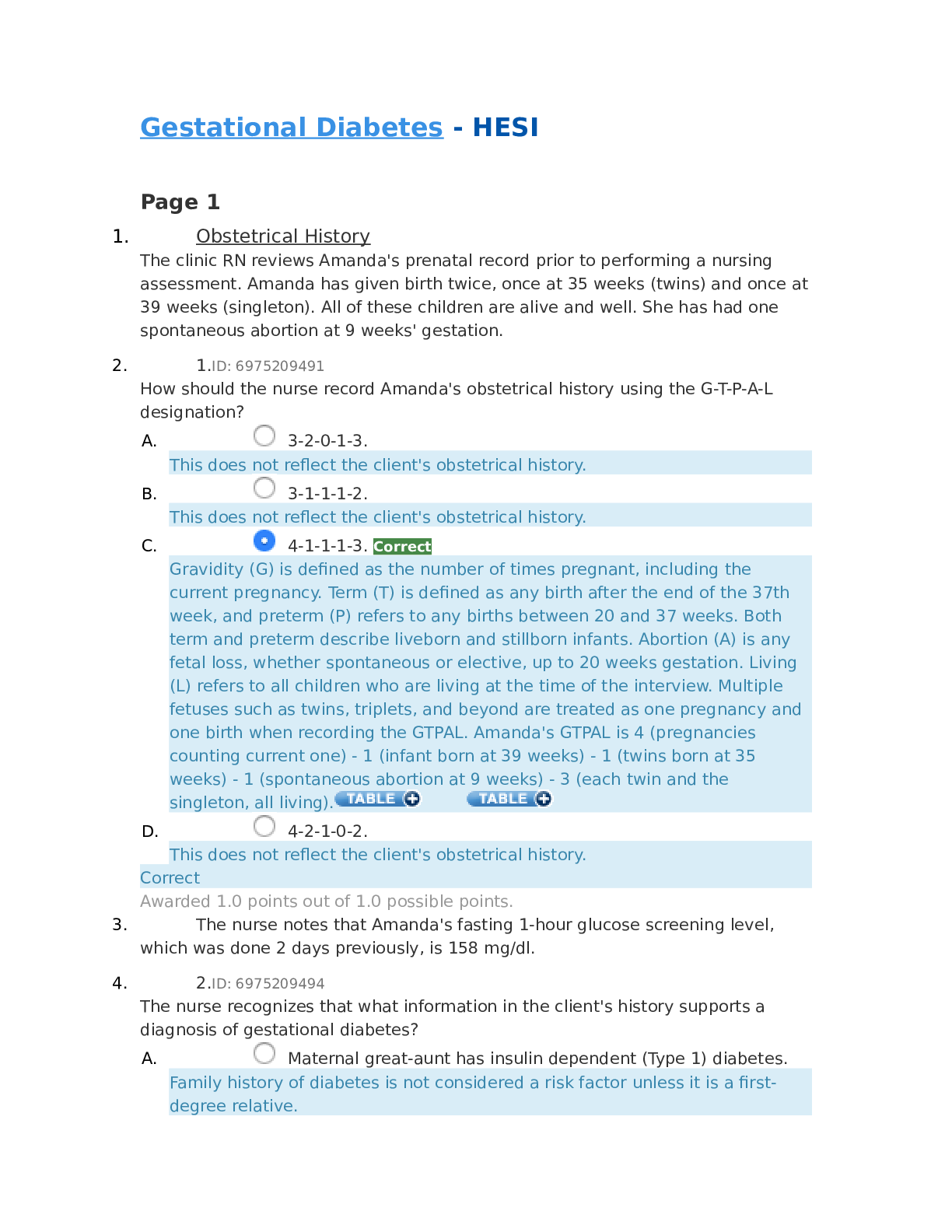
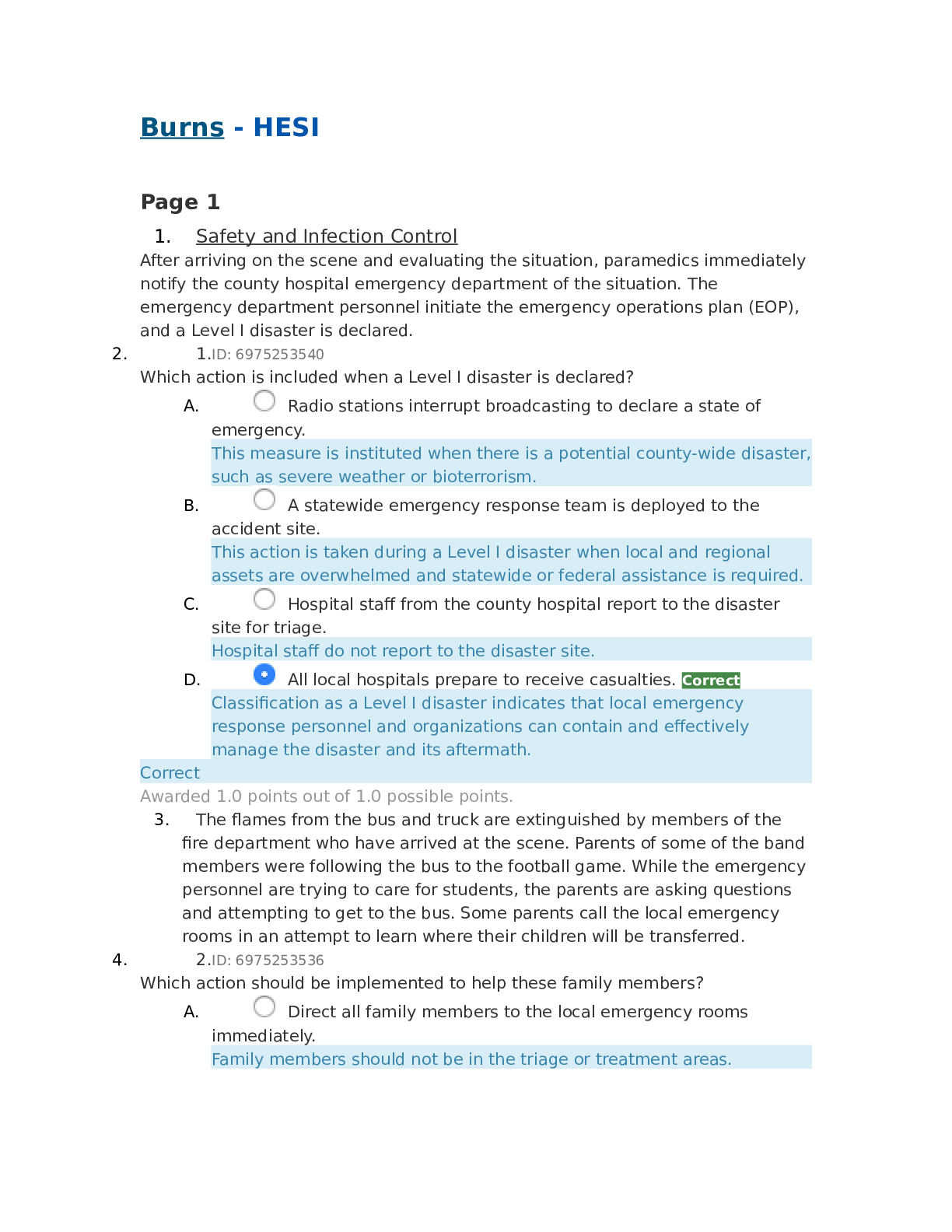





 (1).png)



